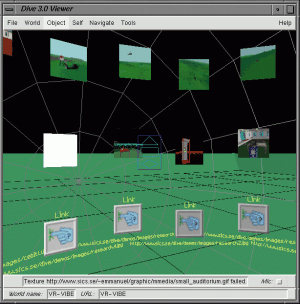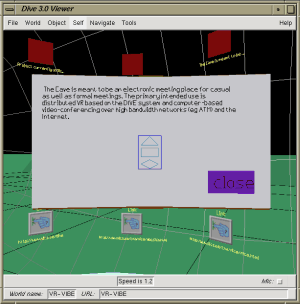WWW3D: A 3D Multi-User Web Browser
Dave Snowdon
Dept. of Computer Science,
The Unversity of Nottingham,
UK
d.snowdon@cs.nott.ac.uk
Lennart Fahlén and Mårten Stenius
Swedish Institute of Computer Science,
SWEDEN
{lef, mst}@sics.se
1. Introduction
Most current web browsers display only the representation of the web document(s)
that the user is currently examining with no indication of the structure
of the document other than by highlighting hypertext links. Those browsers
that do indicate the structure of web documents, such as the Harmony browser
for Hyper-G [Hyper-G], use a different window from that of the document
to present this information to the user. In this paper we will describe
WWW3D a novel browser that provides a single 3D display which integrates
the display of the web documents themselves, the structure of the part
of the web that the user has browsed and history information showing the
links the user has followed in the recent past. WWW3D is implemented in
DIVE [Hagsand 96] and supports multiple concurrent users who are visible
to each other and who may either be browsing the the same or different
sets of web documents.
3. Producing 3D Representation of a Web Page
WWW3D uses the information contained in HTML tags to produce a representation
of the document in 3D space. A web document is represented as a sphere
which is labelled with the document's title. The contents of the document
is placed around the inside surface of the sphere. Displaying large amounts
of text in a satisfactory way is difficult in current VR systems so textual
information is currently represented by icons that can be unfolded to reveal
the entire text. The first few words of the piece of text are displayed
under the icon to give some indication of the contents. Images are displayed
by texture mapping them onto polygons on the inside surface of the sphere.
Finally, links to other documents are represented as icons labelled with
their destination. To reduce the visual complexity of the virtual environment
WWW3D makes extensive use of Level of Detail (LOD) operations. When viewed
from outside a document is represented as an opaque sphere and the actual
document contents is not displayed. When a user enter's a document to view
it the sphere is drawn in wireframe so that the rest of the virtual environment
is still visible. Figure 1 shows the contents of a
web document as displayed by WWW3D.

 Figure 1: A WWW3D representation of the contents of a web document.
Figure 1: A WWW3D representation of the contents of a web document.
4. Browsing the Web Using WWW3D
When the user selects a link icon, WWW3D creates a new sphere representing
the target document and places it near the document the from which the
user selected the link. An incremental version of the Force Directed Placement
(FDP) [Fruchterman 91] algorithm is used to arrange the document sphere
in 3D space. In order to indicate the structure of the portion of the Web
that the user has explored WWW3D draws arrows between the spheres representing
linked documents. In addition to this the brightness of the arrow is dependant
on the time since the user last followed that link therbey providing the
user with a visual representation of their browsing history. As WWW3D parses
a newly retrieved document is checks for links to documents that the user
has already explored and draws arrows to represent them. This means that
at any given moment the complete set of links between document is displayed
without the user having to follow every link. This is intended to aid the
user by indicating links between documents that the user might have been
unaware of. Figure 2 shows the display produced by
WWW3D after the user has browsed a number of documents. The FDP algorithm
has resulted in the formation of clusters of closely linked documents.
The colours of the documents provide some indication of how long ago the
user last visited them.
 Figure 2: A collection of web documents showing the links between
them.
Figure 2: A collection of web documents showing the links between
them.
6. Summary
In this paper we have described WWW3D, a novel Web browser that integrates
information about the contents of web documents, the structure of the portion
of the Web explored by the user and history information. WWW3D is implemented
using the SICS DIVE VR system and can support multiple concurrent users.
Users may communicate with each other using standard facilities provided
by DIVE.
7. References
[Fruchterman 91] Fruchterman, T.M.J., and Reingold, E.M., (1991). Graph
Drawing by Force-directed Placement. Software Practice and Experience,
21(11), 1129-1164.
[Hagsand 96] Hagsand, O. (1996). Interactive Multiuser VEs in
the DIVE System. IEEE Multimedia, 3(1), 30-39.
[Hyper-G] http://www.tu-graz.ac.at/about
Acknowledgements
Many thanks to the Swedish Institute of Computer Science (SICS) for funding
Dave Snowdon as a guest researcher at SICS for the period of this work.
We also thank Emmanuel Frécon for help with DIVE.






